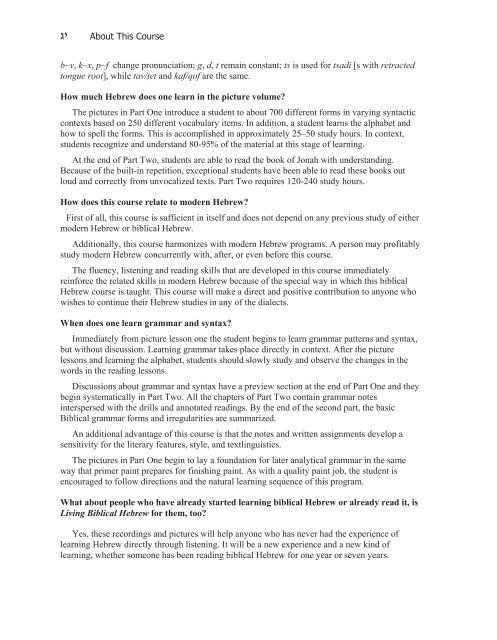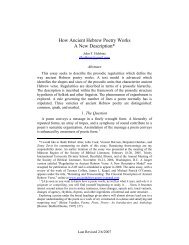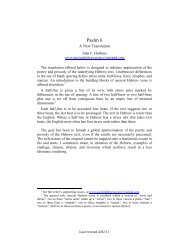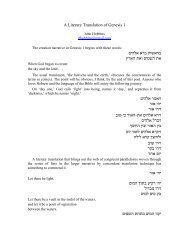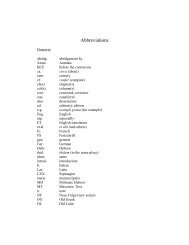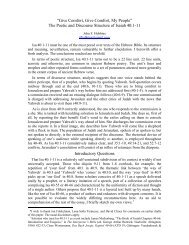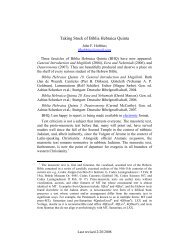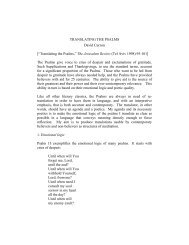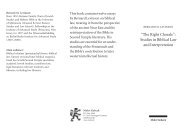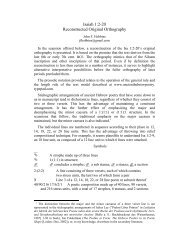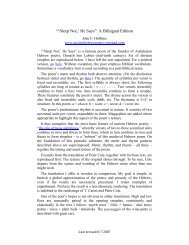Living Biblical Hebrew - Ancient Hebrew Poetry
Living Biblical Hebrew - Ancient Hebrew Poetry
Living Biblical Hebrew - Ancient Hebrew Poetry
Create successful ePaper yourself
Turn your PDF publications into a flip-book with our unique Google optimized e-Paper software.
About This Courseb~v, k~x, p~f change pronunciation; g, d, t remain constant; ts is used for tsadi [s with retractedtongue root], while tav/tet and kaf/qof are the same.How much <strong>Hebrew</strong> does one learn in the picture volume?The pictures in Part One introduce a student to about 700 different forms in varying syntacticcontexts based on 250 different vocabulary items. In addition, a student learns the alphabet andhow to spell the forms. This is accomplished in approximately 25–50 study hours. In context,students recognize and understand 80-95% of the material at this stage of learning.At the end of Part Two, students are able to read the book of Jonah with understanding.Because of the built-in repetition, exceptional students have been able to read these books outloud and correctly from unvocalized texts. Part Two requires 120-240 study hours.How does this course relate to modern <strong>Hebrew</strong>?First of all, this course is sufficient in itself and does not depend on any previous study of eithermodern <strong>Hebrew</strong> or biblical <strong>Hebrew</strong>.Additionally, this course harmonizes with modern <strong>Hebrew</strong> programs. A person may profitablystudy modern <strong>Hebrew</strong> concurrently with, after, or even before this course.The fluency, listening and reading skills that are developed in this course immediatelyreinforce the related skills in modern <strong>Hebrew</strong> because of the special way in which this biblical<strong>Hebrew</strong> course is taught. This course will make a direct and positive contribution to anyone whowishes to continue their <strong>Hebrew</strong> studies in any of the dialects.When does one learn grammar and syntax?Immediately from picture lesson one the student begins to learn grammar patterns and syntax,but without discussion. Learning grammar takes place directly in context. After the picturelessons and learning the alphabet, students should slowly study and observe the changes in thewords in the reading lessons.Discussions about grammar and syntax have a preview section at the end of Part One and theybegin systematically in Part Two. All the chapters of Part Two contain grammar notesinterspersed with the drills and annotated readings. By the end of the second part, the basic<strong>Biblical</strong> grammar forms and irregularities are summarized.An additional advantage of this course is that the notes and written assignments develop asensitivity for the literary features, style, and textlinguistics.The pictures in Part One begin to lay a foundation for later analytical grammar in the sameway that primer paint prepares for finishing paint. As with a quality paint job, the student isencouraged to follow directions and the natural learning sequence of this program.What about people who have already started learning biblical <strong>Hebrew</strong> or already read it, is<strong>Living</strong> <strong>Biblical</strong> <strong>Hebrew</strong> for them, too?Yes, these recordings and pictures will help anyone who has never had the experience oflearning <strong>Hebrew</strong> directly through listening. It will be a new experience and a new kind oflearning, whether someone has been reading biblical <strong>Hebrew</strong> for one year or seven years.


